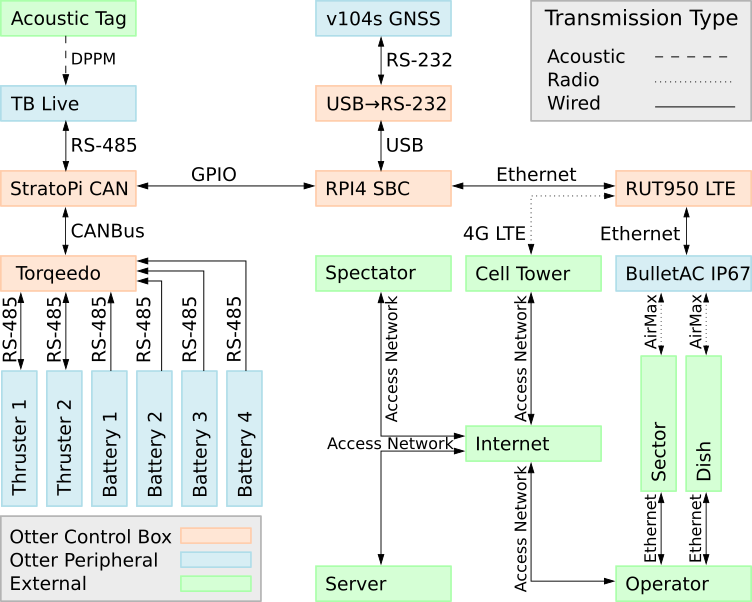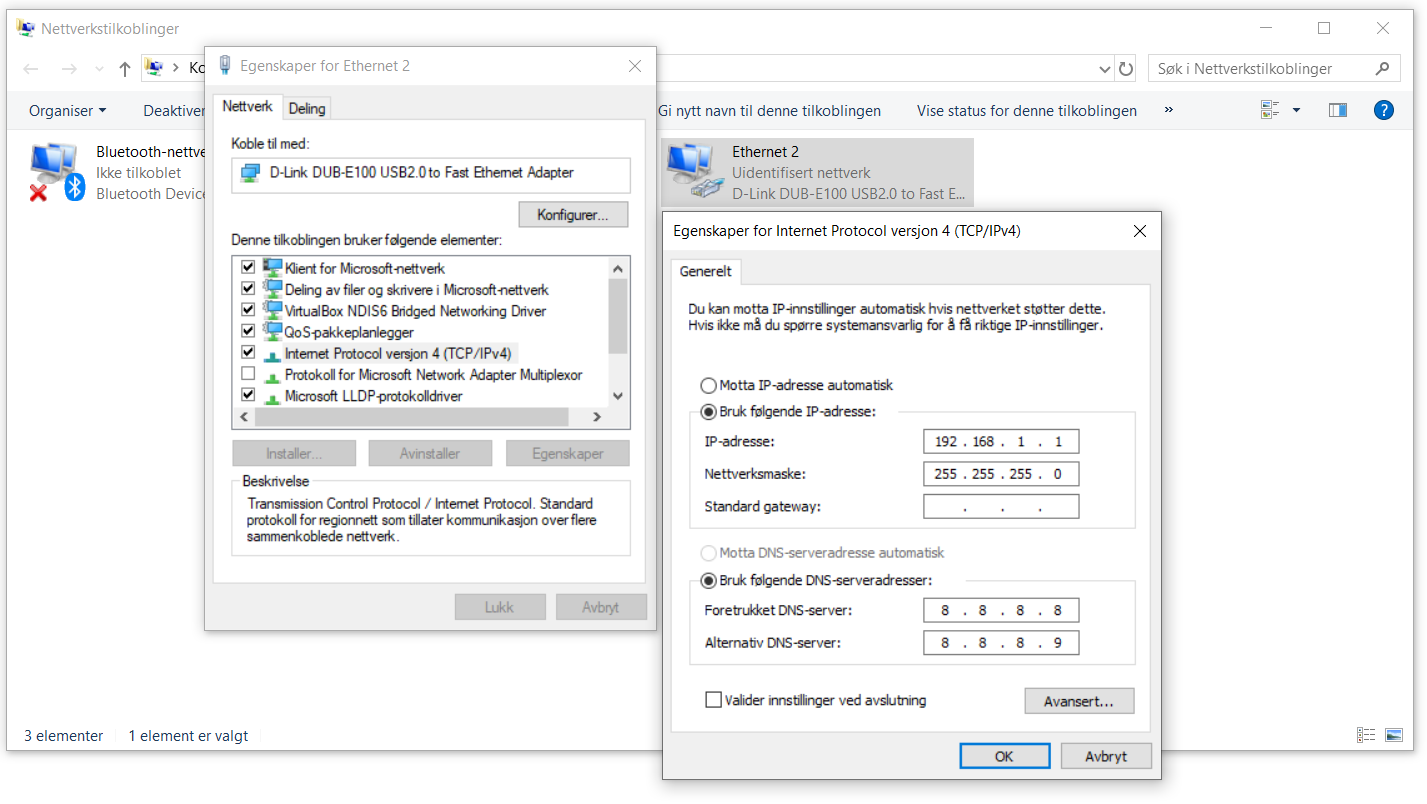Table of Contents
Network Architecture
Short Range: Ubiquiti 5GHz AirMax
AirMax wireless equipment from Ubiquiti provides communication for the Otter and land station. On the Otter, a Ubiquiti Bullet AC IP67 has been used, because of its IP rating. On the land station, two access points are available. One is a 120◦ sector antenna connected to a Ubiquiti Rocket AC. This provides wide coverage at short distances. From experience, around 600-700m can be expected for a solid connection. The other antenna is a Ubiquiti PowerBeam Gen2 dish antenna/access point. This provides a more concentrated signal, and will thus be able to reach longer distances.
Powering to the communications equipment is supplied by using passive 24V Power over Ethernet (PoE). To add power to an Ethernet cable, a PoE injector is placed between the computer and the wireless device. During this project, it was discovered that the Otter only supplied 12V PoE, which led to unstable operation of the Bullet AC. 24V was not available in the power distribution, so a 12V-24V converter was added.
Configuring the devices is done through a separate WiFi connection, since AirMax is not compatible with ordinary WiFi devices.
Cellular: 4G LTE router and Antenna
The Otters have been equipped with Teltonika RUT950 4G routers. The antenna Teoglas Limited MA741.A.BI.001 is mounted on top of the control box, and connected through two SMA connectors to the RUT950.
Server
The IT services at NTNU, orakeltjenesten, has provided a half managed server for the Otter project. This is used to serve
VPN
To connect with the Otters through the web, an VPN has been made. This is running OpenVPN in tunnel mode(TUN), which means that doing routing on data packets (OSI/ISO Layer 3).
Webpage
This webpage is served by an Apache HTTP Server, with a DokuWiki wiki software for content creation/managment.
IMCProxy
To bridge IMC messages across networks, IMCProxy is used.
Land station
The land station uses both an R5AC-lite, and an Power Beam AC gen2 to communicate with the Otters. The Rocket AC lite is coupled with an AM-5G19-120 120° sector antenna.
The Otter
The Otter uses a Bullet AC IP67 to connect to other Otters and the land station. The bullet needs an antenna connected to its 50Ω N-type connector, we have used the Delock WLAN Antenna 802.11 ac/a/h/b/g/n 6 ~ 8 dBi 280 mm omnidirectional pole mounting fixed white outdoor
IP addresses and hostnames
| Local | VPN | Hostname | Model | Location |
|---|---|---|---|---|
| http://10.10.0.1 | 10.8.0.6 | ntnu-otter-01-RUT950 | Teltonika RUT950 LTE | ntnu-otter-01 |
| https://10.10.0.16 | 10.8.0.6:41443 | SectorAC | Rocket M5 R5AC-lite | Communications Tower |
| https://10.10.0.15 | 10.8.0.6:40443 | Otter-01 | Bullet AC IP67 | Otter-01 |
| https://10.10.0.17 | 10.8.0.6:42443 | DishAC | PowerBeam 5AC Gen2 | Communications Tower |
| https://192.168.1.23 | N/A | BrokenRJ45 | Bullet AC IP67 with broken RJ45 connector latch | Loose |
The devices has been configured to use static IP addresses. To manage, connect through ethernet, and set IPv4 range of ethernet interface like the picture.
Hostname otters
| Hostname | IMC address | VPN IP | Model | Location |
|---|---|---|---|---|
| ntnu-otter-01 | 0x2810 | 10.8.0.8 | RPI4 4GB | Otter in dronelab |
| ntnu-otter-02 | 0x2811 | 10.8.0.12 | RPI4 4GB+PPS_dev | box |
| ntnu-otter-03 | 0x2812 | 10.8.0.16 | Not used yet | N/A |
| ntnu-otter-04 | 0x2813 | N/A | Not used yet | N/A |

